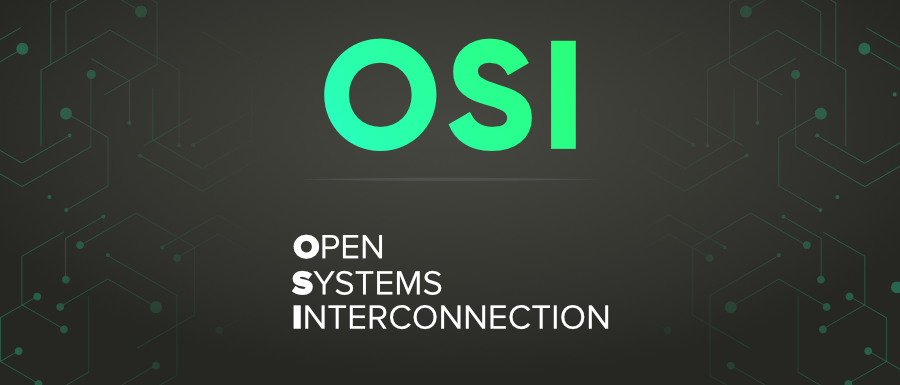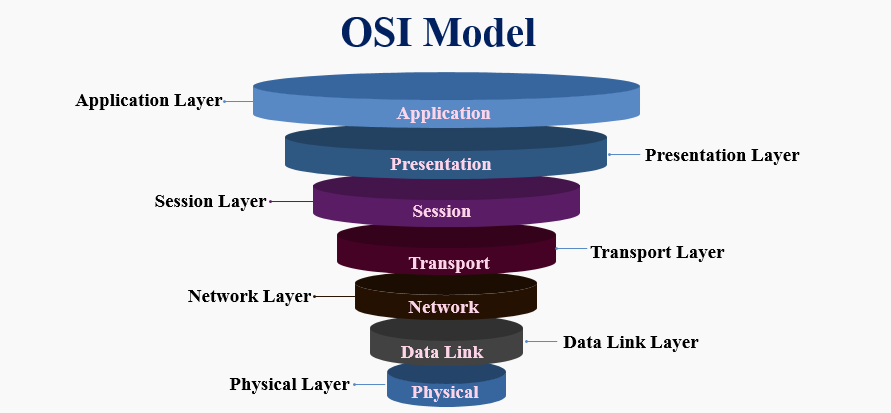The OSI Model, or Open Systems Interconnection Model, is a conceptual framework that standardizes the functions of a telecommunication or computing system into seven distinct layers. Each layer in the OSI Model has a specific role and responsibility in the process of communication between devices or systems in a network. It was developed by the International Organization for Standardization (ISO) to promote interoperability and facilitate communication between different computer systems and networks.
- Introduction : OSI full form
- The OSI Model Layers: OSI full form
- Understanding Communication in the OSI Model: OSI full form
- Interactions Between OSI Layers: OSI full form
- Benefits and Significance of OSI Model: OSI full form
- Comparison with the TCP/IP Model: OSI full form
- Real-World Applications of OSI
- Advantages
- Disadvantages
- Conclusion
- FAQs
Introduction to OSI : OSI full form

The Open Systems Interconnection (OSI) model is a conceptual framework that standardizes the functions of a telecommunication or computing system into seven distinct layers. It serves as a reference model to understand and design network protocols, communication, and networking technologies. The OSI model was developed by the International Organization for Standardization (ISO) to promote interoperability and communication between different computer systems and networks.
Key points to cover in the introduction to the OSI model:
- Purpose of the OSI Model
- Explain that the OSI model was created to facilitate communication between heterogeneous computer systems and networks.
- Highlight its role in standardizing network communication protocols.
2. Historical Background
- Provide a brief history of the OSI model’s development, including its origins in the 1970s and the involvement of various organizations.
The OSI Model Layers : OSI full form

The OSI (Open Systems Interconnection) Model consists of seven layers, each with specific functions and responsibilities. These layers work together to facilitate communication between devices and systems in a network. Here are the seven layers of the OSI Model, listed from the lowest (Layer 1) to the highest (Layer 7):
| Layer | Function | Responsibilities |
|---|---|---|
| Physical Layer | Deals with the physical medium and hardware components of network communication, including cables, connectors, switches, and network interface cards (NICs). | Defines the electrical and mechanical aspects of data transmission, such as voltage levels, data encoding, and signaling. |
| Data Link Layer | Ensures reliable point-to-point communication over a physical link or network segment. | Handles tasks like framing data for transmission, error detection and correction, and controlling access to the physical medium (MAC addressing). |
| Network Layer | Manages the routing of data packets from the source to the destination across multiple networks. | Involves logical addressing, routing, packet forwarding, and determining the best path for data transmission. |
| Transport Layer | Provides end-to-end communication and data integrity between devices. | Establishes, maintains, and terminates connections between devices, handles flow control, and ensures error correction and retransmission of lost data. |
| Session Layer | Manages and controls communication sessions between devices, ensuring that data is properly synchronized and organized. | Establishes, maintains, and terminates sessions, as well as managing dialog control and data synchronization. |
| Presentation Layer | Focuses on data translation, encryption, and compression to ensure that data is in a suitable format for transmission. | Handles data encoding and decoding, translation between different data formats, and encryption/decryption for security. |
| Application Layer | Provides various network services and application-level protocols to end-users and applications. | Supports application-level communication, user authentication, and data exchange, including the use of application-specific protocols like HTTP, FTP, and SMTP. |
Understanding Communication in the OSI Model : OSI full form
- Sender and Receiver: Communication begins with a sender, often referred to as the source, and a receiver, which is the destination. These can be computers, servers, or any networked devices.
- Layered Approach: The OSI Model divides the communication process into seven distinct layers, with each layer responsible for specific functions. These layers work together in a hierarchical manner to ensure efficient communication.
- Data Encapsulation: As data moves from the sender to the receiver, it undergoes a process called data encapsulation. This involves adding headers, trailers, and control information at each layer to create a data packet.
Interactions Between OSI Layers : OSI full form
| OSI Layer | Function |
| Application Layer | Provides services to the user, such as file transfer, email, and remote login. |
| Presentation Layer | Translates the data from the application layer into a format that can be understood by the network. It also encrypts and decrypts the data to protect it from unauthorized access. |
| Session Layer | Establishes and manages a communication session between two hosts. It ensures that the data is delivered in the correct order and that any errors are corrected. |
| Transport Layer | Provides reliable end-to-end delivery of data. It breaks the data up into smaller units called segments and ensures that they are all delivered correctly. |
| Network Layer | Responsible for routing the data from the source to the destination. It uses a routing table to determine the best path for the data to take. |
| Data Link Layer | Responsible for framing the data and adding error-checking bits. It also handles the physical transmission of the data over the network. |
| Physical Layer | Lowest layer of the OSI model. It is responsible for transmitting the bits of data over the physical medium, such as copper wire or fiber optic cable. |
Benefits and Significance of OSI Model : OSI full form
- It provides a common framework for understanding and designing network protocols. The OSI model breaks down the communication process into smaller, more manageable chunks, which makes it easier to understand how networks work and how to design protocols that work effectively.
- It facilitates the development of interoperable network devices and applications. Because the OSI model is a standard, network devices and applications that are designed to conform to the model can communicate with each other, even if they are made by different vendors.
- It helps to troubleshoot network problems. By understanding how the different layers of the OSI model interact, network administrators can better diagnose and resolve problems that occur in a network.
- It is a teaching tool. The OSI model is a useful tool for teaching networking concepts to students and IT professionals.
Comparison with the TCP/IP Model : OSI full form
| OSI Layer | TCP/IP Layer |
| Physical Layer | Physical Layer |
| Data Link Layer | Data Link Layer |
| Network Layer | Internet Layer |
| Transport Layer | Transport Layer |
| Session Layer | Application Layer |
| Presentation Layer | Application Layer |
Real-World Applications of OSI
- Designing network protocols: The OSI model can be used to design new network protocols by breaking down the communication process into smaller, more manageable chunks. This makes it easier to understand the different aspects of the communication process and to design protocols that work effectively.
- Troubleshooting network problems: By understanding how the different layers of the OSI model interact, network administrators can better diagnose and resolve problems that occur in a network.
- Teaching networking concepts: The OSI model is a useful tool for teaching networking concepts to students and IT professionals. It provides a common framework for understanding how networks work and how to design and troubleshoot them.
Advantages
Standardization: The OSI model presents a familiar set of requirements and pointers for hardware and software program producers, ensuring exclusive structures and networks can interoperate efficiently.
Layer Independence: Each layer in the OSI model operates independently of the others, making an allowance for easier troubleshooting, improvement, and updates with out affecting the entire network machine.
Modularity: The OSI model’s layered technique lets in network functionalities to be divided into smaller, practicable modules, simplifying the layout and implementation of community protocols.
Interoperability: By adhering to standardized protocols, special networks and gadgets can speak seamlessly, enhancing compatibility and connectivity throughout diverse systems.
Flexibility: The OSI model supports multiple network configurations and protocols, allowing networks to evolve to new technologies and necessities with out sizeable reconfiguration.
Scalability: Networks designed the use of the OSI version can easily scale up or down, accommodating boom or reduction in network size and complexity with out considerable remodel.
Improved Troubleshooting: The distinct layers of the OSI model permit network directors to pinpoint and clear up issues more efficaciously by separating issues to specific layers, thereby reducing downtime and maintenance costs.
Disadvantages
Complexity: The OSI version is frequently taken into consideration too complicated and bulky for sensible implementation, particularly in smaller or easier network systems.
Inefficiency: Due to its layered structure, the OSI version can introduce extra overhead and inefficiency, as information need to pass thru a couple of layers, each including its personal headers and trailers.
Overhead: Each layer inside the OSI model has its own set of protocols and processes, that may cause tremendous processing overhead and reduced overall performance, in particular in high-velocity networks.
Adoption: The OSI model is theoretical and now not as extensively adopted in exercise as compared to the less complicated and more streamlined TCP/IP version, that’s the inspiration of the internet.
Implementation: Real-global network protocol stacks frequently do now not match well into the OSI model’s seven-layer structure, main to discrepancies and inconsistencies in implementation.
Learning Curve: The OSI model can be tough to apprehend and examine, specially for novices, due to its certain and abstract nature.
Redundancy: Some features may be duplicated across a couple of layers, leading to redundancy and inefficiency in community operations and protocol layout.
Conclusion
The Open Systems Interconnection (OSI) model is a conceptual framework that describes how data should be exchanged between computers. It divides the communication process into seven layers, each of which performs a specific function.
The OSI model is not a real-world protocol, but it is a useful tool for understanding and designing network protocols. It is also used as a teaching tool in many universities and colleges.
Overall, the OSI model is a valuable tool for understanding, designing, implementing, and troubleshooting computer networks. It is a widely accepted standard that is used by network engineers, developers, and other IT professionals around the world.
FAQs
Q1: What is the OSI model?
A: The OSI (Open Systems Interconnection) model is a conceptual framework used to standardize and guide the design and implementation of network communication protocols.
Q2: What is the main purpose of the OSI model?
A: The main purpose is to standardize networking protocols to enable interoperability between different systems and technologies.
Q3: How does the OSI model differ from the TCP/IP model?
A: The OSI model has seven layers, while the TCP/IP model has four layers. The TCP/IP model is more practical and widely used in real-world networking, especially on the internet.
Q4: Which layer is responsible for routing data packets?
A: The Network Layer (Layer 3) is responsible for routing data packets between different networks.
Q5: What is the function of the Transport Layer?
A: The Transport Layer (Layer 4) ensures reliable data transfer between devices, providing error checking, flow control, and retransmission of lost data.



















